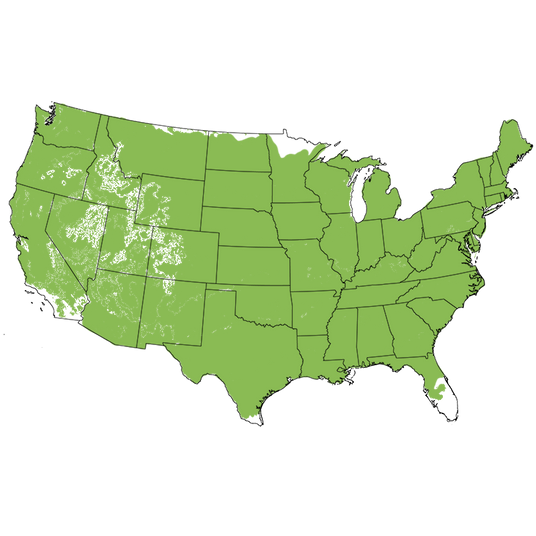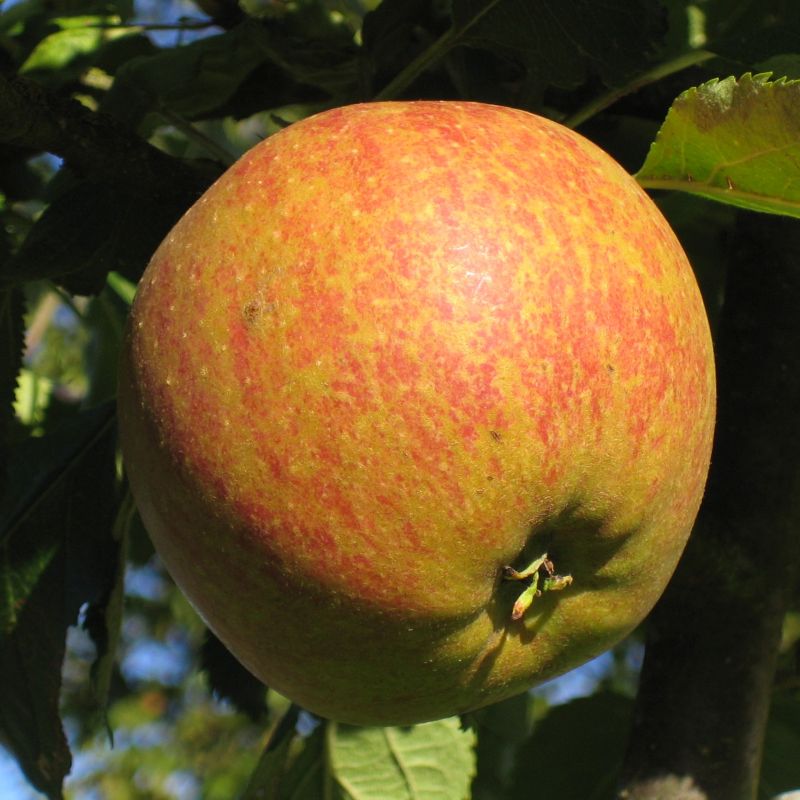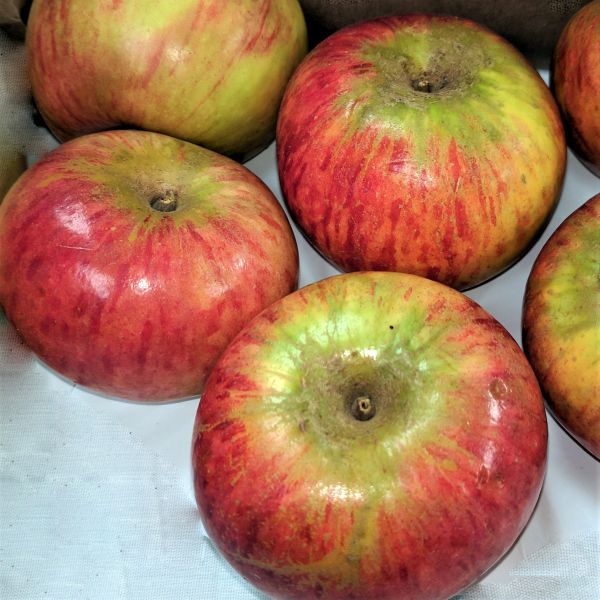Cox Orange Pippin Apple Tree
Malus 'Cox's Orange Pippin'
Plant Sentry™
Plant Sentry™

Plant Sentry™ Protected
Your order is protected by our compliance system that:
- Prevents restricted plants from shipping to your state
- Ensures plants meet your state's agricultural requirements
- Protects gardens from invasive pests and diseases
Delivery and Shipping
Delivery and Shipping
Delivery and Shipping
Fast, Safe Plant Delivery
Ships in 3-4 business days • Tracking provided • Weather protected
| Under $50 | $9.99 |
| $50 - $99.99 | $14.99 |
| $100 - $149.99 | $16.99 |
| $150 - $198.99 | $24.99 |
| $199+ | FREE |
✓ Zone-specific timing • ✓ Professional packaging • ✓ Health guarantee
Understanding Plant Options
Nature Hills offers plants in two main formats:
- Container Plants: Grown in pots with soil, sized by container volume and plant age
- Bare Root Plants: Dormant plants without soil, sized by height measurements
Container Plant Sizes
Container sizes indicate plant age and growing capacity rather than liquid volume equivalents. Our containers follow industry-standard nursery "trade gallon" specifications, which differ from standard liquid gallon measurements.
Young Plants (6 months to 18 months old)
| Container Size | Actual Volume | Metric Equivalent |
|---|---|---|
| 2" x 2" x 3" | 0.18 - 0.21 dry quarts | 0.20 - 0.23 dry liters |
| 4" Container | 0.31 - 0.87 dry quarts | 0.35 - 0.96 dry liters |
| 4.5" Container | 0.65 dry quarts | 0.72 dry liters |
| 6" Container | 1.4 dry quarts | 1.59 dry liters |
| 1 Quart | 1 dry quart | 1.1 dry liters |
| 5.5" Container | 1.89 dry quarts | 2.08 dry liters |
Established Plants (18 months to 2.5 years old)
| Container Size | Actual Volume | Metric Equivalent |
|---|---|---|
| 2 Quart | 2 dry quarts | 2.2 dry liters |
| #1 Container | 2.26 - 3.73 dry quarts | 2.49 - 4.11 dry liters |
| 5" x 5" x 12" | 3.5 - 4.3 dry quarts | 3.85 - 4.74 dry liters |
Mature Plants (2-4 years old)
| Container Size | Actual Volume | Metric Equivalent |
|---|---|---|
| #2 Container | 1.19 - 1.76 dry gallons | 5.24 - 7.75 dry liters |
| #3 Container | 2.15 - 2.76 dry gallons | 8.14 - 12.16 dry liters |
Large Plants (3-5 years old)
| Container Size | Actual Volume | Metric Equivalent |
|---|---|---|
| #5 Container | 2.92 - 4.62 dry gallons | 12.86 - 20.35 dry liters |
| #6 Container | 5.25 - 6.01 dry gallons | 23.12 - 26.42 dry liters |
| #7 Container | 5.98 - 6.53 dry gallons | 26.34 - 28.76 dry liters |
Bare Root Plants
Bare root plants are sold by height from the root system to the top of the plant. Plants may exceed minimum height requirements.
Common Sizes:
- Trees: 1 foot, 2 feet, 3 feet, 4 feet, 5 feet, 6 feet
- Shrubs & Perennials: 1 foot, 18 inches, 2 feet
Important Notes
Container Volume Specifications
- Trade Gallon Standard: Our containers follow industry-standard "trade gallon" specifications established by the American National Standards Institute (ANSI Z60.1) for nursery stock
- Volume Variations: Actual soil volume may vary due to plant root systems and growing medium settlement
- Age Indicators: Container size primarily indicates plant age and maturity rather than liquid volume equivalents
Growing Conditions
- Plant size can vary based on variety and growing conditions
- Container size helps indicate plant maturity and establishment level
- Larger containers generally mean more established root systems and faster landscape establishment
Seasonal Availability
- Bare root plants are available seasonally when dormant
- Container plants are available throughout the growing season
- Specific varieties may have limited availability in certain sizes
Questions?
For questions about specific plant sizes or availability, please contact our plant experts who can help you choose the right size for your landscape needs.

Plant Sentry™ Protected
Your order is protected by our compliance system that:
- Prevents restricted plants from shipping to your state
- Ensures plants meet your state's agricultural requirements
- Protects gardens from invasive pests and diseases
Plant Profile & Growing Essentials
Cold hardy, Edible, Ornamental Berries/Fruit, Flowering, Thornless, and Attracts pollinators
-
Botanical Name
-
Height
-
Width
-
Growing Zones
-
Sunlight
-
Growth RateModerate
-
Flower Color
-
Leaf Color
-
Fall Color
-
Pollinator FriendlyYes
-
Pollinator Required
-
Bloom PeriodLate Spring
Finest Dessert Fruit Cox Orange Pippin Apple Tree!
- Yellow Fruit With Orange Red Blush
- Excellent Dessert Apple
- Complex Rich Flavor of Sweet Orange & Mango!
- Upright Growth
- Easy Care & Low Maintenance
- Fragrant Pink Buds Open White
- Cold Hardy & Full Sun
- Antique Variety
- Pollinators Flock to the Blooms
- Firm Texture & Medium-Sized
- ~800 Chill Hours
- Cider, Sauce, Baked & Fresh-Eating!
A classic English Apple, often regarded as the finest of all dessert apples, remains unsurpassed for its richness and complexity of flavor!
Cox Orange Pippin Apple Tree (Malus 'Cox's Orange Pippin') has a striking, attractive orange-red coloring and is definitely a superb looking and extremely tasty Apple. Its medium-sized fruit has yellow skin blushed with orange-red and striped with crimson brown. Turning redder the longer they remain on the tree.
This chance seedling has been growing since the 19th century and does well in cool summers and coastal areas.
Grown for cider, cooking, and eating. The fine-textured, creamy white flesh ripens mid-fall to early winter and will not tolerate extreme cold, heat or low humidity. A heavy bearing variety, you'll have a good crop in no time!
Sweet, slightly tart and sometimes described as almost spicy, the flesh is creamy-yellow, firm and juicy with a crisp texture. This is not just a tasty fruit, but aromatic as well! Often paired with both savory recipes, it has been noted as pairing excellently with pork dishes.
Create incredible pies and tarts, pastries and other baked recipes! Often used in England to make chutney, your jams, apple butter and preserves will gain some vintage flavor with these versatile apples that puree beautifully! Juice or create your own cider, or simply eat right off the tree!
This upright, spreading tree has lovely deciduous foliage with a touch of fall color. In fall, it is covered in pure white, cup-shaped flowers in mid and late spring, followed by first-class, juicy dessert apples for harvesting in early to mid-October.
One neat feature is when shaken, the seeds rattle inside the ripe fruit!
How to Use Cox Orange Pippin Apple Tree In The Landscape
Gorgeous trees on their own as specimens and accent plants, the beautiful spring bloom of these fantastic mid-sized trees are suitable for average-sized gardens. Home orchards and edible landscaping are great for these vintage trees!
Plant near your garden and patio to provide shade and ornamental blooms. Anchor large plantings with these beautiful trees and enjoy watching your family pick their own apples each September!
Why not plant a specimen tree near a window to enjoy its beautiful look from close up? The pretty spring flowers and developing fruit are so interesting. Keep things easy for yourself by removing any lawn and placing mulch underneath Apple trees.
Nothing is like a home-grown sweet and juicy apple straight from the tree and warmed by the sunshine! Picked a bit earlier, these take on a more sweet-tart flavor and store nicely and firmer for baking and preserves. Pick later and they're sweet and fantastic for fresh eating and sauces!
Plant long rows of these lovely trees along your drive or the side of your property. Providing beautiful privacy and beauty in the spring, summer and fall!
We bet your family and friends will certainly help you enjoy that fresh fruit! Create a hedges by planting several varieties 15 feet apart on center. Measure from the center of one to the center of the next.
Fantastic dual-purpose gardening, fragrant flowers, handsome foliage, a touch of fall color and wonderful landscape form, you won't go wrong including a modest-sized Apple tree into your garden plans this year!
Save room for one of Cox Orange Pippins pollinators, an early-blooming variety, it works best with Fuji, Granny Smith and Honeycrisp Apples!
#ProPlantTips For Care
Fruit trees need full sun, 8 plus hours a day of sunshine provide the most blooms and the largest yields.
Morning sun is especially good for fruit trees. The drying power of the morning sun will quickly dry off the foliage. Keep the leaves dry when you can.
Hardy in USDA hardiness zones 4 through 9, these trees thrive throughout most of North America. Good disease resistance and low maintenance, this Apple variety is fantastic for the home gardener.
Moderate moisture needs, protect your investment and boost yields by not allowing your tree to endure drought at all. A thick layer of mulch over the root system insulates the roots from heat and cold, plus holds in more moisture!
Any well-drained soil and organically rich medium are great for these trees! If you need to improve drainage, create a raised garden bed to plant in. Mound up the soil to 18 inches high and 3 feet wide. Plant in that mound.
Prune in summer to keep the height where you want it. Tip prune to an outside-facing bud. These trees are often trained as Espalier and can be kept trained smaller for smaller yards!
Most pruning is done to keep the canopy open to increase air circulation, reducing fungal issues and disease.
Cox Orange Pippin Apple Tree is an ornamental apple and beautiful landscape tree! Add vintage flavor and beauty to your recipes with this hardy tree from Nature Hills today!
Cox Orange Pippin Apple Tree Frequently Asked Questions
When to Plant Cox Orange Pippin Apple Trees
Planting Bareroot trees as soon as you can dig a hole in spring and until hot weather, the earlier the better. Plant container Apple trees throughout the growing season with complete success - that is the benefit of container plants - to extend the planting season. Your County Agricultural Extension Office is a great resource for first and last frost dates in your area.
How to Plant Cox Orange Pippin Apple Trees
Dig a large hole only as deep as needed to accommodate the bareroot or container root ball, and twice as wide. Add Nature Hills Root Booster to speed root establishment. Remove the pot or bag and situate it into the hole so the top of the soil (soil line if bareroot), is level with the new location's soil being careful not to plant too deep. Water in again very well and backfill with the same soil you dug up, tamping down gently to ensure there are no air pockets.
Top off with a 3-4 inch thick layer of Arborist mulch. Consider staking your tree to keep its trunk growing straight for the first year to ensure it stands tall against strong winds and drifting snow.
When to Prune Cox Orange Pippin Apple Trees
Trim off any broken branches from delivery as soon as you take them out of the box. Prune and trim apple trees while dormant, in late winter or early spring, before you see new growth.
How to Prune Cox Orange Pippin Apple Trees
Dormant prune to:
- Remove any double leaders or narrow crotch angles
- Eliminate any crossing branches
- Thin interior branching and leave the fruiting spurs and strong branches in place opening up the canopy
- Branching at least 24-36 inches above the ground
Prune Apple trees in the summer to:
- Control size and shape by reducing the length of longer new growth on vigorous trees
- Remove water sprouts on the main trunk or older branches in the crown
- Remove suckers at the base of the trunk
- Thin fruit during heavy years on established trees
How to Care for Cox Orange Pippin Apple Trees
Growing an apple tree is easy when proper soil, good drainage, attention to moisture, and regular fertility are maintained. Once you've chosen an apple tree that works for your climate, in the size you need for your landscape, and its pollinator (if needed), then you've accomplished half the battle!
- Apple trees do best in full sun and well-drained soil
- Water your apple trees when it gets dry - especially during the fruit production stage, and drought periods to keep it stress-free
- Use arborists' wood chips to mulch over the roots of your apples and have your soil tested to see what your soil may be lacking before adding fertilizers
- Maintenance pruning and shaping
Apple trees will tolerate a wide range of soils, so long as water and nutrients are not limited and the pH level is adequate.
How to Fertilize Cox Orange Pippin Apple Trees
For the first year, water alone is most important. It is always best to get a soil test to see what your soil is lacking before adding more fertilizers. Once established, a fertilizer routine may be beneficial. We do offer some excellent slow-release organic options, applied according to the package directions.
Fruit trees need more phosphate and it's possible to apply too much nitrogen which affects the soil's pH. Test soil acidity or alkalinity using a pH Tester.
Fertilize in spring when you first see new growth emerging.
- Don't overdo it
- Phosphates are your friends
- Pay attention to pH in areas with extremely high or low soil pH
- Follow the directions
Cox Orange Pippin Apple Tree Pollinating Info
Cox Orange Pippin is not self-fruiting and needs a pollinating partner. Pair with one of these varieties:
Harvest Times for Cox Orange Pippin Apple Trees
Cox Orange Pippin’s are typically ready to harvest in mid August through September.
Early-Season? Mid-Season? Late-Season? The terminology can be confusing for new apple tree growers. Weather, climate and your tree determine when it's ripe.
For Apples:
- Early-season is usually June-July
- Mid-season can be August-September
- Late-season can be from late September-November
The growing season consists of spring, summer, and fall, and varies with climate and weather. Areas with longer growing seasons in the warmer hardiness zones can greatly affect the harvest times for each particular apple variety grown in your area. Learn which growing zone you are in.
What Shipping Options Do You Offer?
NatureHills.com works closely with our growers and nursery professionals to ensure we ship when it is most appropriate for your area. Our goal is to deliver the hardiest plants by avoiding extreme high and low temperatures. Check out our shipping schedule for more information and to learn our wills and won'ts when it comes to shipping plants. Find your Cox Orange Pippin Apple Tree for sale here at NatureHills.com!











